In 1867 the Pacific Coast Business Director carried a quarter page advertisement for the firm which read: “KNIGHT & CO. Assayers of Gold, Silver and Ores, of Every Description. 32 D Street, Marysville, California. Assays Guaranteed.” John J. Ford, Jr. believes that this firm, in business about ten years, was earlier located in Sacramento.
The firm apparently was one of a number of enterprises which served as a convenience for miners, refining and assaying gold and delivering the product in bars.
Little is actually known concerning this pioneer assaying firm. They first appear listed as assayers in Marysville, the county seat of Yuba County, California, in H.H. Bancroft’s “Hand-Book Almanac for the Pacific States: An official Register and Business Director … for 1864,” compiled late in the previous year. The firm is not listed in the 1863 edition of the Bancroft reference. The latest listing located for Knight & Co. was found in the “San Francisco Semi-Annual Trades Guide and Pacific Coast Directory,” published byD. M. Bishop & Co. of San Francisco in July, 1874. The same 32 “D” Street address is given. While Knight & Co. have a quarterpage display advertisement in the “Pacific Coast Business Directory for 1867” (page 65, Advertising Department, rear of book), the first year of this H. G. Langley publication, no mention of the company can be found in the second edition bearing the dates 1871-73. Chances are that the firm was a small one, despite their known ten years in business, as most of the banking references given in their 1867 ad are of small institutions, half of them in Marysville. Knight & Co. are believed to have been located earlier in Sacramento, as the Ford collection contains a $41 .58 gold ingot of low fineness bearing that designation. Directories consulted subsequent to 1875 contain no mention of the company either in Marysville or Sacramento, but references published 1862 and earlier have not as yet been available to us.
There are several gold Knight & Company ingots, all of which are believed to be forgeries. At least one example is mentioned below.
11.44 oz Knight & Company, Assayers, Marysville, California. $232.23 gold ingot.
Actual weight 5,494.5 grains. Extremely Fine or better. Virtually as issued.

One of a group of 15 ingots of varying weights found by Carlton Wells of Oakland, California, in June, 1965, on the bank of the Sacramento River. Serial numbers range from 1782 to 1796. Quite possibly these were seized years ago in a stagecoach or other robbery and were secreted by desperados who never returned to claim them. A similar piece, serial no. 1782, appeared in the 1980 NASCA sale as Lot 2027.
In the form of a bar, as illustrated, there is the Serial number 1794, the inscription KNIGHT & CO., an Internal Revenue stamp, and further inscriptions noting the weight to be 1 1 .44 ounces and the fineness to be 982. The value $232.23 is given below. The stamp “SMV” indicates “standard mint value.” The edges of the bar are plain. The back is stamped with the inscription “TM CO. SAC. CAL,” for the Tecumseh Mining Co. in Sacramento. A large, heavy, impressive, and valuable piece of Western Americana! ($5500-6500)
Obtained from John J. Ford, Jr. in 1968.
[03/1982] https://archive.org/details/henryhcliffordco1982bowe/page/n53/
9.51 oz Knight & Company, Assayers, Marysville, California. $182.10 gold ingot.
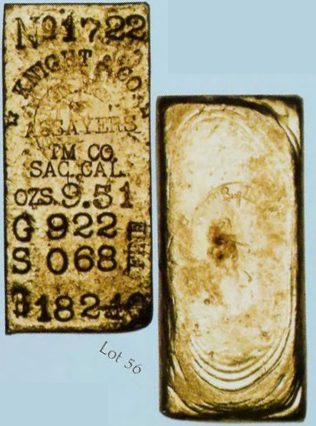
This ingot, bearing the earlier serial number 1722, differs slightly in style from that offered in the preceding lot. The “TM CO, SAC. CAL.” inscription appears on the front, in addition to the inscriptions referring to Knight & Company, the serial number (1722), and other information. On one edge of the bar is stamped G $181.26, and on the other edge is stamped S $.84, indicating the respective values of gold and silver. The back of the bar contains a faintly impressed Internal Revenue stamp. Extremely Fine or better condition. Rarer than the last.
Another large, impressive, and valuable piece. ($6000-7000)
Obtained from John J. Ford, Jr. in 1971.
[03/1982] https://archive.org/details/henryhcliffordco1982bowe/page/n53/
Very Rare and Intriguing Knight & Co. Gold Assay Bar
Fantasy Issue
Likely Made in the 1950s and 1960s
Knight & Co. Assayers Gold Ingot. No. 1791. 7.05 Ounces. 982 Fine. Face Value: $143.12.
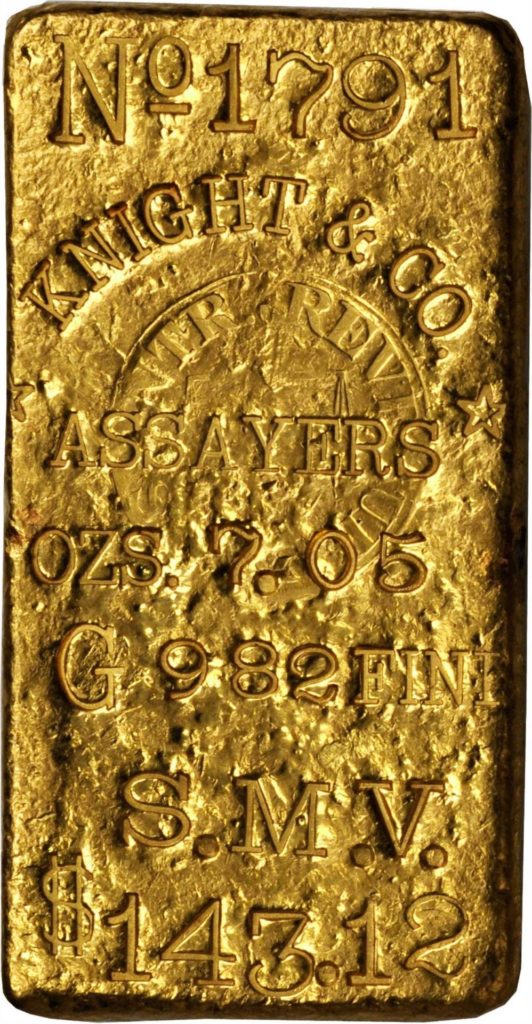
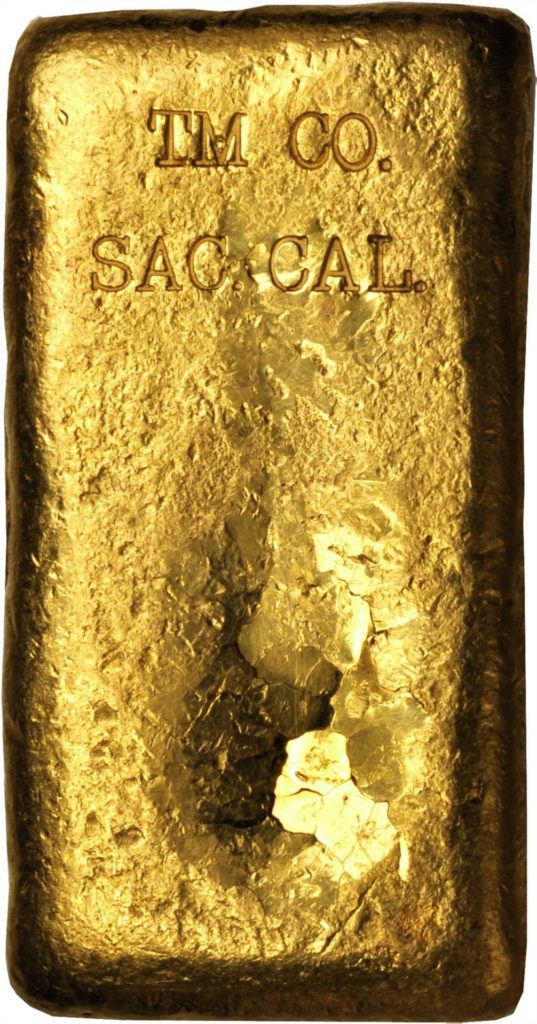
60 mm x 31 mm x 7 mm. The face is stamped NO 1791 / KNIGHT & CO. / ASSAYERS / OZS. 7.05 / G 982 FINE / S.M.V. / $143.12. Two stars flank the word ASSAYERS, while beneath that stamp is the remnants of an earlier stamp that is now only partially legible, although one of the words is clearly REVENUE while the other includes the letters S and NTR. The back of the ingot is stamped TM CO. / SAC. CAL. A bright yellow gold example with an area of light toning on the right edge and the usual light scuffs and other trivial signs of handling.
Similar to the bar photographed on page 261 of Dan Owens’ California Coiners and Assayers (Bowers & Merena and Stack’s, 2000), and lot 190 of the Gibson Collection (Stack’s November 1974) this ingot was produced by a company that was in operation from 1863 to the 1870s in Marysville, California. David E. Knight, one of the early settlers in Marysville, was born in Vermont in October 1825, and made his way to California in 1852. Starting in San Francisco, then spending three years in Sacramento, Knight moved to Marysville in 1856, where he established several important businesses and remained there until his death in 1900. Among these were an electric company, a foundry, a railroad company, a publishing company, a laundry, a bank, and a woolen mill. In 1863, D. E. Knight opened an assay office in Marysville with D.C. Marchand, the former partner in the Harris & Marchand Company. It is quoted from the June 2, 1863 Marysville Appeal, “NEW ASSAYING FIRM. D.E. Knight and D. Marchand have opened an assay office in the room formerly occupied by H. Harris & Co. They are both practical men and will conduct their business in a proper manner. Mr. Knight has made assays from early every silver lode in the Humboldt County and copper lode in Yuba and Nevada counties, and he is supposed to be thoroughly posted with regard to them.”
On November 28, 1864, a notice in the Daily California Express noted that the firm moved from their original location on E Street to 32 D. Street in Marysville. Less than two years later, the Marysville Daily Appeal recorded in the February 11, 1866 issue, that the partnership of D.E. Knight and D. Marchand was dissolved “by mutual consent. All outstanding accounts of the late firm will be settled by D.E. Knight.” In 1869, Knight became a director of the Marysville Savings Bank, and Frank W.H. Aaron was his secretary. The following year, an ad appeared in the Marysville Daily Appeal “Frank E.H. Aaron (Successor to Knight & Co.) Assayer of Gold, Silver and Ores No. 312 D Street Marysville…”
By the time David E. Knight passed on January 5, 1900,, he was one of the most prominent figures in Marysville, California. His obituary in the Friday evening edition of the January 5, 1900 Marysville Daily Democrat, aside from only mentioning his many business successes (oddly enough, they omit his career in assaying). eulogized him as “Charitable and philanthropic, his wont was to turn his thoughts on the many in need of aid…”
A very rare bar, the extensive Ford Collection only contained a silver bar from this Assayer. In cataloging lot 190 in the Gibson Collection (Stack’s November 1974), we noted: “…actually one of 15 gold ingots of similar type, there being twelve of this variety (Knight Type III). Found by Carlton Wells of Oakland, California, and friends, in June, 1965 on a bank of the Sacramento River, this ingot was most probably loot from a stage or similar robbery. Ex John J. Ford, Jr., R.F. Batchelder. Knight & Co. ingots of Type III, IIIa, and IIIb are consecutively numbered ranging from #1782 to #1796. One ingot of this variety remains in the Ford Collection, another is displayed in the ‘Bank of California’s Museum of Money of the American West’ in San Francisco (No. 1792), a third is in the H.H. Clifford holdings, presently exhibited at the second San Francisco Mint Museum, S.F. (No. 1974), while a fourth is in the National Collection, Smithsonian Institution, Washington, D.C. (No.1795).”
One of 15 reported found in the above sited serial number range along the Sacramento River, the most recent theory is that these were produced in the 1950s or early 1960s. The research conducted shows that punches for the serial number match others from issues that have conclusively been identified as productions from this era. We are offering this bar as a fantasy piece, created for collectors circa 1950s to early 1960s and were marketed to collectors at that time, thus the appearance in the above mentioned collections. The silver bar that John Ford had was Ex. Garrett, purchased in 1923 from B. Max Mehl. An interesting and rare piece that has an intriguing tale to tell.
7.05 oz Knight and Company Gold Ingot, ca. 1864-1869 (NOT!)
“7.05 ounces, 982 fine, No. 1791, $143.12 SMV (standard mint value). The central obverse displays an Internal Revenue stamp, while the reverse is stamped TM CO. SAC. CAL. for Tecumseh Mining Company, Sacramento, California. This ingot was originally offered as lot 2128 in Superior’s January 1985 sale of the Dr. Jerry Buss Collection, where it was cataloged as: “Fine and quite lustrous. Technically unique, as are any assay ingots differing in serial weight and denomination, but actually one out of 15 known, as specimens of this type have serial numbers running from 1782 to 1796.
Found by Carlton Welles of Oakland, California, and friends in June, 1965 on the banks of the Sacramento River. This ingot was probably loot from a stagecoach or similar robbery. There are a total of 24 or 25 Knight ingots of three different types known, but only 15 are of this type, which have the value expressed as SMV (standard mint value). All known bars of this type first appeared at the 1969 Glendining Sale, November, 1969.”
Based on the discovery from the 60’s its another reason to believe it may have ties to Ford as a counterfeit.
[06/2002] https://coins.ha.com/itm/miscellaneous/undated-circa-1864-1869-knight-and-company-assayers-gold-ingot-705-ounces-982-fine-no-1791-14312-smv-standard-mi/a/292-7665.s ($12,650)
[12/2012] https://www.icollector.com/Knight-Company-Ingot-CA-Sacramento_i14654261 ($18,522)
[08/2015] https://auctions.stacksbowers.com/lots/view/1-1DD42/knight-co-assayers-gold-ingot-no-1791-705-ounces-982-fine-face-value-14312 ($9,987)
[01/1985] https://archive.org/details/drjerrybusscolle1985supe/page/240/mode/2up?q=ingot
6.80 oz No 1796 $138.05 (1864-69). Gold Assay Ingot. KNIGHT & CO. * ASSAYERS *
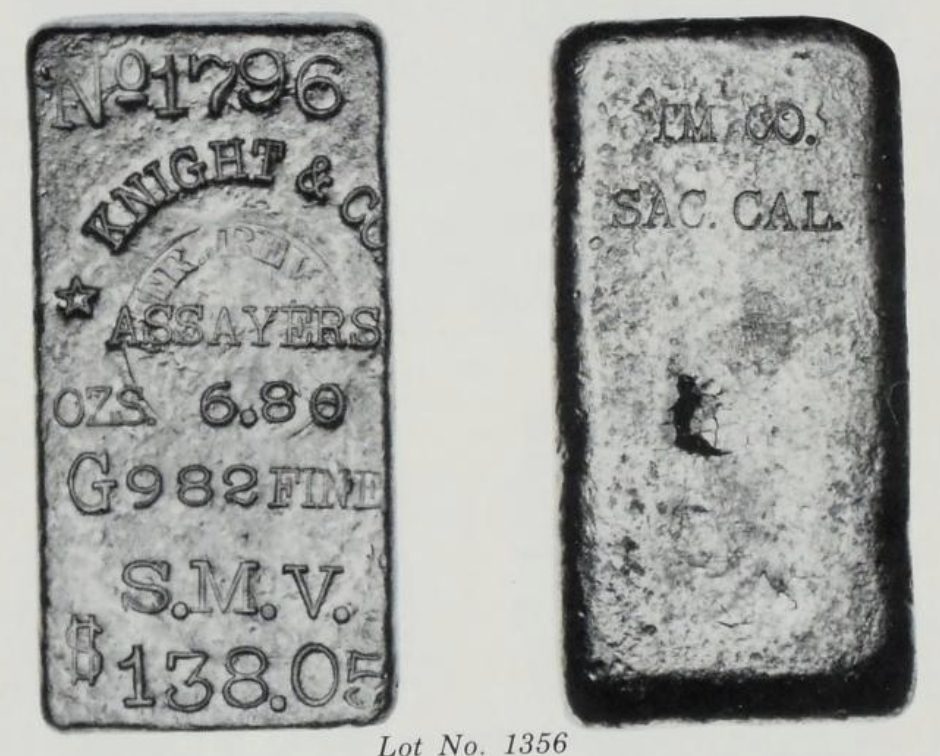
No. 1796 / (name) / (title) / OZS. 6.80 (0 over 6) / G(old) 982 FINE / S(tandard). M(int). V(alue). / $138.05. The stamps ASSAYERS and OZS. 6.80 over U. S Internal Revenue bullion tax stamp. Reverse: T(ecumseh) M(ining) CO. / SAC. CAL. 3,268.35 Grains. Extremely Fine. Technically unique (as would be any assay ingots that differ in serial number, weight, and denomination), but actually one of fifteen gold ingots of similar type, there being twelve of this variety (Knight Type III). Found by Carlton Wells of Oakland, California, and friends, in June 1965 on a bank of the Sacramento River, this ingot was most probably loot from a stage or similar robbery. Ex John J. Ford, Jr., R. F. Batchelder. Knight & Co. ingots of Type III, Ilia, and lllb, are consecutively numbered, ranging from #1782 to #1796. One ingot of this variety remains in the Ford collection, another is displayed in the Bank of California s Museum of Money of the American West” in San Francisco (#1792), a third is in the H H. Clifford holdings, presently exhibited at the second San Francisco Mint Museum, S.F. (#1794), while a fourth is in the National Collection, Smithsonian Institution, Washington, D.C. (#1795). Irom Stacks Gibson Collection, lot 190, November 1974. (SFF COLOR PLATE)
[02/1983] Stacks https://archive.org/details/robisoncollectio1982stac/page/157/mode/2up
ND (ca. 1864-9) Knight & Co., Assayers (32 “D” Street, Marysville, Calif.) Gold & silver Conversion Bar, #1720
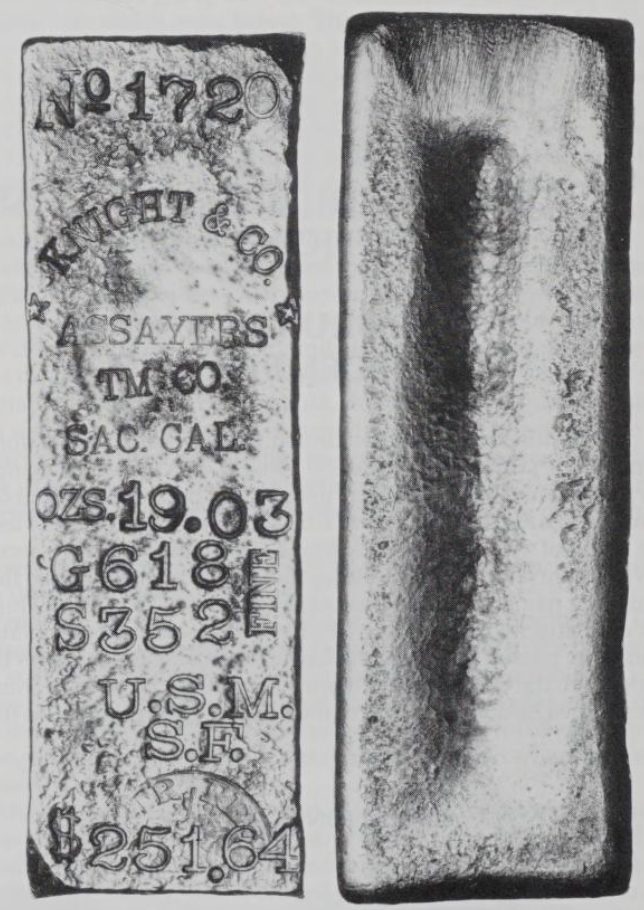
30 x 97mm., 19.03 Ozs. (9,128.1 grains). Gold .618 Fine, Silver .352 Fine (Gold $243.01; Silver $8.63.) U.S.M. S.F. $251.64. (Photo) ($10,000-Up)
One of only two specimens known of the Type 1 bar, issued for the “T(ecumseh) Mining) Co.” of Sacramento (the other specimen being #1719). This specimen was formerly in the “Money of the American West” museum of the Bank of California in San Francisco, and came from the Carlton Wells discovery hoard of June, 1965, on the banks of the Sacramento River. Indeed, the present specimen was the original discovery piece which loas spotted from across the river in the sunlight where part of the riverbank had collapsed, and it bears light file marks on the upper reverse where the discoverers tested it to see if it was gold! In addition to the obz’erse legends and values, and the Internal Revenue bullion tax stamp at bottom, the left edge is stamped with the gold value and the right edge with the silver as listed above, and the upper right and lower left corner tips are stamped “K“ as an assay verification.
[04/1980] https://nnp.wustl.edu/library/auctionlots?AucCoId=511370&AuctionId=521430
ND (before 1864) Knight & Co., Assayers — T(ecumseh) M(ining) Co., Sac(ramento) Cal. Gold & Silver Refined Transport bar, #1724
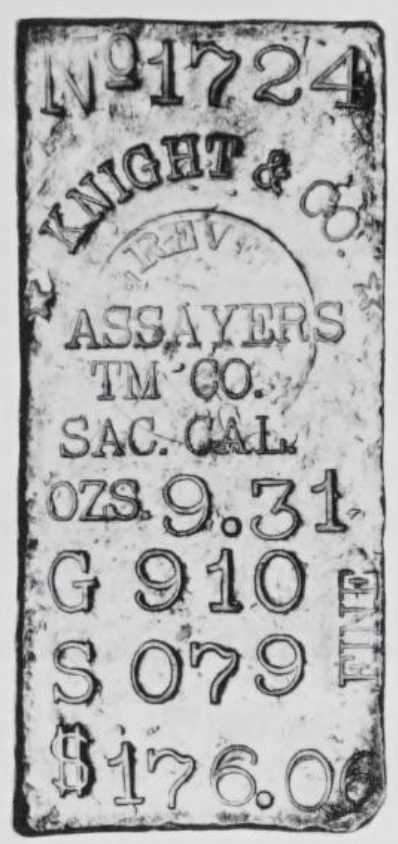
30 x 68 x 8mm., 9.31 Ozs. (4471.65 grains.) Gold .910 Fine, Silver .079 Fine; Value $176.06 (Photo)
Left edge stamped “G $175.12″. Right edge stamped “S $.94” One of the 7 known specimens of the “Type 11” issue by Knight &Co., the majority of bars with their imprint being Type III. Counterstamped with the Internal Rev¬ enue seal on both sides, indicating payment of the bullion tax. Slightly pale, greenish gold, an attractive as well as a rare bar. (Known Type II bars have serial numbers ranging from 1721-1727 exclusively.) Ex John J. Ford, Jr., 1964; and present consignor.
[04/1980] https://nnp.wustl.edu/library/auctionlots?AucCoId=511370&AuctionId=521430
6.75 oz ND (ca. 1864-9) Knight & Co., Assayers (32 “D” Street, Marysville, Calif.) Gold transport bar, #1782

31 x 60 x 6mm., 6.75 Ozs. (3244.85 grains.) Gold .982 Fine, Value $137.02 S.M.V. (standard Mint value.)
The lowest number known in the Type 111 bars of this company, with In¬ ternal Revenue stamp on olwerse, “T(ecumseh) M(ining) Co. , Sac. Cal. ” on rev. Ex John J. Ford, Jr., toj. Hanson 1973; Hanson to F. S. Werner 2177; I . S. W. to Ron Gillio. 6177; Gillio to our present consignor 9/77. 15 knoum of this type, serial numbers running from 1782 to 1796.
[04/1980] https://nnp.wustl.edu/library/auctionlots?AucCoId=511370&AuctionId=521430
A reference to another Knight & Co gold ingot was located in “American Coin Treasures and Hoards and caches of other American numismatic items” by David Bowers, 1997.
7.10 oz Knight & Co $144.13 Gold Ingot No 1788

See: https://archive.org/details/americancointrea1997bowe/page/272/
7.90 oz No 1725 $186.68 (1864-69). Gold Assay Ingot. KNIGHT & CO. * ASSAYERS *

This item is now at the Smithsonian.
See: https://americanhistory.si.edu/collections/nmah_1101713
